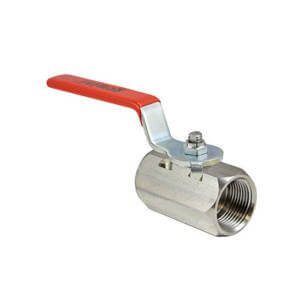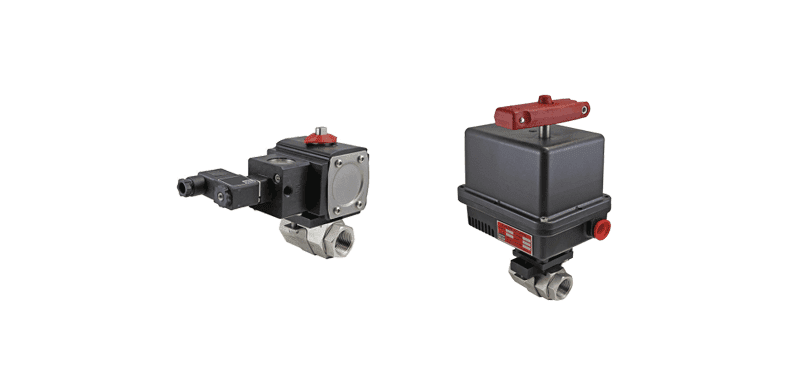A Guide to Valve Selection: The Pros and Cons of Different Types of Ball Valves
The post A Guide to Valve Selection: The Pros and Cons of Different Types of Ball Valves appeared first on POWER Magazine.

Before selecting an engineered solution for any fluid control application, it is crucial to understand the unique application and overall value that each ball valve provides. Ball valves come in a wide variety of styles, materials and actuation types, with each form offering different results.
Here's a guide to help you learn what you need to know to ensure that your projects are executed with the right type of valve for operational efficiency.
How do ball valves work? A ball valve is a quarter-turn valve that uses a ball with a hole drilled through it to control the flow of media. The hole is referred to as the port or orifice, and when opened, it aligns with the valve body to permit flow.
The ball is contained within the valve body and is held in place by two cup-shaped seals commonly referred to as seats. To allow media to flow through the valve, the ball is rotated 90 degrees so that the port is aligned parallel to the valve body. To turn off flow, the ball is rotated back so that the port is perpendicular to the valve body. These rotations (known as cycles) can be triggered manually through the use of a handle, or automatically through the use of a pneumatic, electric or hydraulic actuator.
Ball Valves by StyleLet's start with two-way ball valves, which are used for traditional on/off control. These are the most commonly used, and lowest-cost type, of ball valve. These valves are ideal for a wide variety of original equipment manufacturer (OEM) and end-user applications, including testing, fluid filling, batching and draining.
Here are the pros and cons of this type of ball valve:
Pros: Can be quickly cycled (turned on or off), especially with pneumatic, or hydraulic actuation.
Pros: Provide effective long term sealing for low to moderate pressure applications.
Pros: Lowest upfront cost.
Cons: Not ideal for applications that require precise control of media flow volume: Suitable for on / off control only.
Cons: Design not suitable for reparability.
 This two-way ball valve is used for traditional on/off control. Credit: Gemini Valve
This two-way ball valve is used for traditional on/off control. Credit: Gemini Valve
Three-way ball valves are the most popular type of multi-port ball valve. This style is commonly used in applications with more than one source of media or to divert media in two different directions. Depending on the flow direction, the three ports are assigned as either one outlet and two inlets, or one inlet and two outlets. They are designed for applications such as process control, sterilizers/autoclaves and bottling and dispensing.
Pros: Same fast cycling as 2-way ball valves.
Pros: Provides the ability to mix types of media (Selector Valve).
Pros: Provides the ability to divert the flow of media (Diverter Valve).
Cons: More expensive than 2-way valves.
Cons: Most models function as diverter or selector valves only and cannot completely turn off the flow of media.
Cons: Not easily repaired.
A three-piece ball valve features a main body and two pipe connectors, which are threaded or welded to a pipe. The 3-piece design allows the valve to be easily taken apart and repaired without removing the pipe connectors from the piping. Three-piece ball valves are ideal for high-cycle and/or heavy pressure applications that experience a lot of wear and tear.
Pros: Easy to disassemble for maintenance.
Pros: Variety of connection types available.
Pros: Can offer long-term cost savings in applications susceptible to extreme wear and tear.
Cons: Higher upfront cost.
Ball Valve Actuation TypesAll ball valves are powered manually or through automated energy sources. Actuators or manual handles are mounted to the valve stem and work as control mechanisms to open or close the valve. With the appropriate power source for your project, you can reduce maintenance costs, increase uptime and maximize safety.
 Here are examples of a pneumatic (at left) and an electric actuated ball valve. Credit: Gemini Valve
Here are examples of a pneumatic (at left) and an electric actuated ball valve. Credit: Gemini Valve
Pneumatic actuated ball valves use compressed air to automate the control of media. Pneumatic actuated ball valves are commonly used on OEM equipment where compressed air is accessible, such as liquid filling equipment or automotive fluid fill systems. They are also found in factories and manufacturing facilities.
Pros: Low cost.
Pros: High durability.
Pros: Fast cycle time.
Pros: Spring-return fail-safes available.
Pros: Resistant to overheating and moisture.
Pros: Double-acting models offer significantly smaller form factor than industry standard electric actuators.
Cons: Require compressed air or gas to operate.
Cons: Fast cycle time can increase risks of water hammer.
Cons: Higher operating costs.
Additional key considerations for pneumatic valve actuators include:
- Power source: Require a compressed air supply
- Speed: To open or close the valve, most pneumatic actuators take half a second to one full second, depending on the model.
- Durability: High quality double-acting pneumatic actuators can last for up to cycle counts of 1,000,000 +/- when used within specifications. Spring-return models are normally less durable than double-acting models.
- Safety features: Double-acting models provide failsafe in event of power failure. Spring-return models provide failsafe for both power and compressed air failure.
Electric actuated ball valves, also known as motorized ball valves or rotary ball valves, are the most popular choice for ball valve automation. This form of ball valve uses an electric motor to operate the ball valve and control the flow of media. Electric actuated ball valves are used by OEMs, as well as for industrial and commercial applications.
Pros: Slower cycle time is less prone to causing water hammer.
Pros: Low operating costs.
Pros: Minimal noise.
Pros: Compressed air not required to operate.
Pros: Rotary and linear options available.
Cons: Slower cycle time compared to pneumatic.
Cons: Generally higher cost.
Cons: Fail-safe options not widely available.
Additional key considerations for electric valve actuators include:
- Voltages: Electric actuators are available in a wide variety of voltages.
- Durability: High quality electric actuators can be extremely durable but are not likely to last as long as double-acting pneumatic actuators.
- Speed/Torque Options: Most electric actuators take approximately six seconds to open/close the valve. The exact time will depend on the manufacturer/design.
- Protection Ratings: The National Electrical Manufacturers Association (NEMA) sets guidelines for the use of electric products in certain environments. Below are four of the most common ratings for electric actuators:
- NEMA 4: Weatherproof, for indoor and outdoor use. This rating defines the necessary protection needed against water, dirt and ice.
- NEMA 4X: This rating follows the NEMA 4 guidelines with added protection from corrosion.
- NEMA 6: For submersible use in water, quarries and mines. The exact design depends on the specific pressure and time the product is submerged.
- NEMA 7: For indoor use in hazardous areas. This rating means products are capable of withstanding pressure from internal explosions.
Hydraulic actuated ball valves are similar to pneumatic actuators, only they use pressurized fluid instead of air or gas. The fluid-either water or oil-is fed to one or both sides of a piston to create movement. Hydraulic actuators can provide significantly more force/speed than pneumatic actuators due the use of un-compressible fluid in the place of compressed air.
Pros: Can provide more force than pneumatic actuators.
Cons: Prone to leaking hydraulic fluid, reducing efficiency.
Cons: Prone to contamination issues.
Cons: Requires significant operator support.
Due to their versatile nature, ball valves are one of the most widely used industrial equipment in existence. Each ball valve and actuator type have advantages and drawbacks to consider when selecting the right option for your intended application. It's best to first determine your invariable needs and then decide what additional features will best suit your application.
-George Packard is vice president of Marketing at Gemini Valve, a family-owned American manufacturer of automated and manual ball valves.
The post A Guide to Valve Selection: The Pros and Cons of Different Types of Ball Valves appeared first on POWER Magazine.